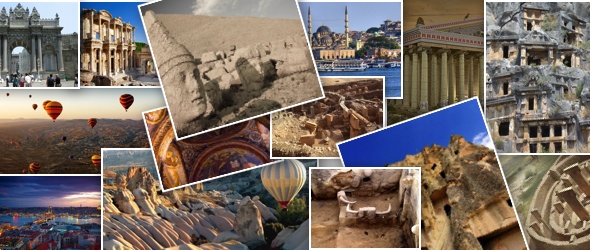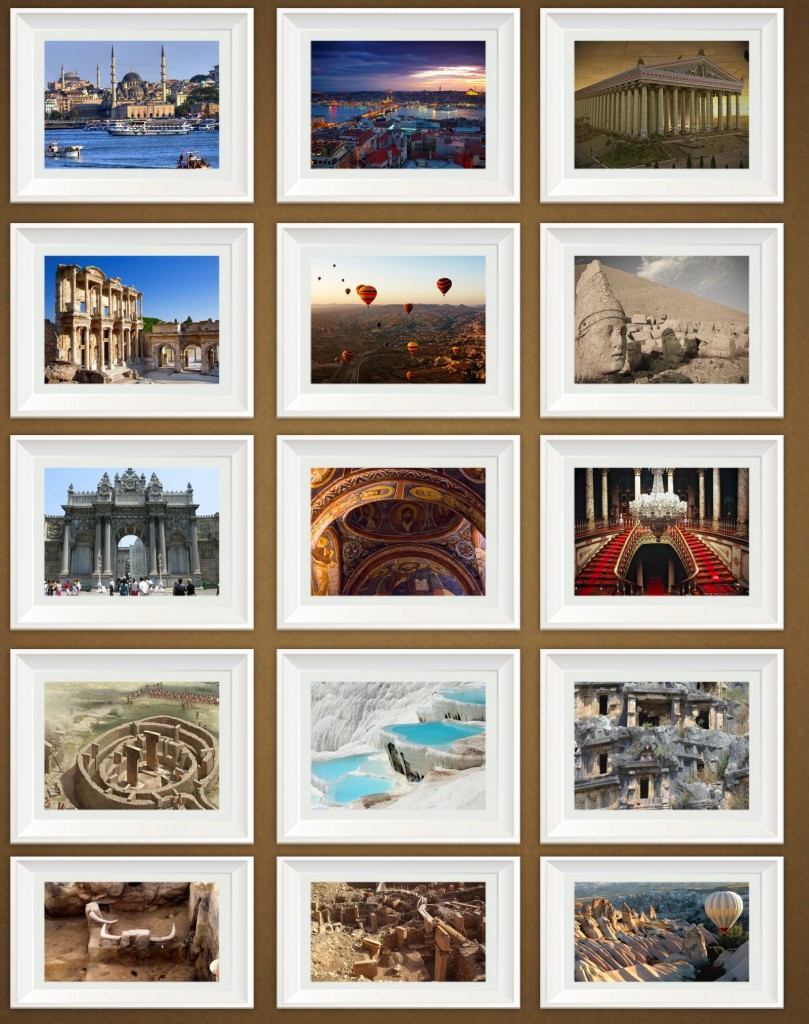It is quite impossible to enumerate here all the places of historic and touristic interest which Turkey has to offer. We are therefore confining ourselves to listing the most outstanding ones in chronological order.
Hittite monuments:
200 km from Ankara, on the road to Samsun, can be found the Hittite capital of Hattusas (Boğazköy)… the famous YAZILIKA-YA base-reliefs… The unparalleled remains of ALACAHÖYÜK which can be seen in Ankara’s “Hittite” Museum (Museum of Anatolian Civilizations)… and, south of Adana, KARATEPE.
Phrygian monuments:
Not far from Ankara is the site where, in 333 B.C. Alexander the Great, during his conquest of Asia, cut the Gordion knot. One should not miss seeing the Necropolis of the city of Gordion and, close to Eskişehir, the city where the famous King of the Phrygians, Midas, was said to have turned everything, including the rivers, into gold.
Monuments of the Greco-Roman Age:
On the shores of the Aegean is the renown city of Priam and Paris – TROY – made famous by Homer’s Oddysey. ASSOS, on whose Acropolis can still be seen remains of the Temple of Athene… PERGAMON with its theatres, temples and famous Asclepion… SARDIS, the capital of Crossus… and one of antiquity’s most fascinating centres, EPHESUS… one of the Seven Wonders of the World, the Temple of Artemis dedicated to the Goddess of Plenty… PRIENE, famous for its theatre and Temple of Athene., the Temple of Apollo in DIDYMA which once rivalled that of the Oracle of Delphi… antiquity’s biggest theatre at MILETUS and KNIDOS, which can boast owning antiquity’s most beautiful statue of Venus.
On the Izmir – Antalya road, APHRODISIAS, where every year new discoveries are brought to light… PAMUKKALE, site of one of nature’s wonders and the remains of HIERAPOLIS.
Continuing along the Mediterranean coast;
The Lycian graves carved out of rocks, TELMESSOS and FETHİYE.. XANTHOS and its acropolis… MYRA, now known as Demre, birthplace of Father Christmas (St. Nicholas) with its theatre, church and necropolis…. TERMESSOS, its theatre and many tombs…
And Antalya: Hadrian’s Wall made of beautiful white marble., the largest stadium of Roman times, PERGE… ASPENDOS, the greatest and best preserved theatre of antiquity, and SIDE, lying between two beautiful beaches, with its theatre, temples, baths, incomparable statues…
On Mount NEMRUD near Adıyaman in south-eastern Turkey
The awe-inspiring tomb of the Commagene king Antiochus I, who wanted his burial place to be as close as possible to the celestial throne of Zeus.
And finally the ROMAN BATHS and TEMPLE OF AUGUSTUS in Ankara.
Monuments of the Byzantine Age:
The Byzantines, influenced variously by the East, by Rome and by Christianity, left many beautiful works of art in Anatolia.
IN CAPPADOCIA (GOREME);
The unigue Valley of Goreme with its rupestral churches decorated with iconograph type frescoes… churches of conic and pyramidical shapes are located in E most unusual natural setting. The following are also worth mentioning: The Alahan Monast ery on the Karaman – Silifke road… the valley of the Thousand and One Churches, the remains of innumerable Byzantine churches and basilicas… and further on, south of Mardin, the Monastery of Abdin. Ancient Nicaea (now Iznik)… and some of the most beautiful remains of the Roman, Byzantine and Ottoman periods. In the region of Kars, a beautiful example of Armenian work, the Ani ruins. And last but not least, the Akdamar Church, built on the islet which is in the middle of lake Van.
IN TRABZON
Among the many Byzantine churches, the most famous is the Church of St. Sophia…. south of Trabzon.the incredible Sumela Monastery built into the face of a mountain.
Monuments of the Seljuk and Ottoman Period (Turkish Islamic Art):
- KONYA: The best examples of the art of the Seljuk State can be seen in its principal city, Konya. Here you have the Alaeddin Mosque, the Karatay Medrese (school of religious learning), the Ince Minare Medrese, and above all the shrine to the famous Turkish poet-philosopher, Mevlana Celaleddin Rumi, the Mevlana Tomb, which today is a Mevlana museum.
- NİGDE: The Alaeddin Mosque, Sungur Bey Mosque, Ak Medrese, Hüdavent Tomb.
- KAYSERI: The Fortress, Huant Medrese, Honat Hatun Mosque, and the Revolving Dome.
- TOKAT: The Gök Medrese
- SIVAS: The Çifte Minare Medrese, the Tombs of Emir Süleyman and Hatunlye.
- DIVRIGI: The Ulu (Great) Mosque with its splendid Portals.
In addition, there are the Ancient Ahlat ruins on the western shores of Lake Van; the Sultanhan on the Konya-Aksaray
IN ISTANBUL
Here you have what for hundreds of years was considered as the greatest example of architecture, the famous Byzantine Church of St. Sophia (today a museum)… the Church of St. Irene, the Chora Church embellished with beautiful Byzantine frescoes and mosaics, the ancient Hippodrome, the Obelisk of Constantine, the Underground Cistern with their Corinthian columns, known as the Yerebatan Sarayı, the two-storey Valens Aqueduct built of soft rock, the Fethiye Camii “Pammakaristos Church” with its beautiful mosaics, the Palace of Constantine and the famous Byzantine city ramparts.
It is virtually impossible to give a complete list of the monuments built over the centuries in the Ottoman capital of Istanbul. To cite only a few of the most outstanding: the Suleymaniye Mosque, Mosque of Rustem Pasha, the So-kullu Mehmet Paşa Mosque, and the Şehzadebaşı Mosque, all of which are masterpieces of the Architect Sinan. Among other beautiful Ottoman monuments are the Beyazit Camii, the Blue Mosque, the Fatih Camii and the Eyup Mosque and Mausoleum on the Golden Horn. Let us not forget the Topkapi Palace, the Dolmabahce Palace, the Yıldız Park and Beylerbeyi Palace and the Çinili Köşk.
Also the fortresses of Rumelihisari (Fortress) and Anadolu Hisar, facing one another on opposite shores of the famous Bosphorus and the Yedikule Castle… the fountains of Sultan Ahmet III and Tophane.
And the most outstanding monument of the Turkish Republic, the magnifiecent edifice to Atatiirk’s memory, the Anitkabir (Mausoleum of Atatürk) in Ankara.
The places of historic and touristic interest which Turkey has to offer. ,

